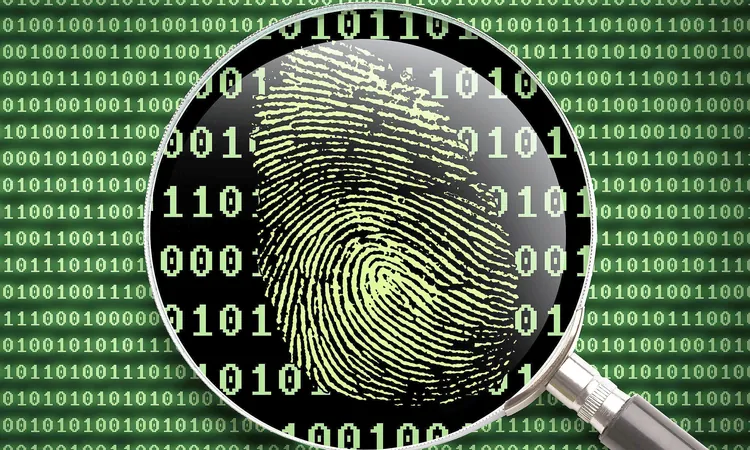
Revolution in Forensics: AI Challenges Fingerprint Uniqueness and Its Implications for Justice
2025-04-07
Author: Ting
Introduction
Fingerprint analysis has long been considered a cornerstone of criminal investigation for over a century. Law enforcement agencies rely on the belief that each fingerprint is unique—a reliable identifier that links suspects to crime scenes. However, a groundbreaking study led by researchers at Columbia University has unveiled shocking findings that may overturn this entrenched belief.
The Study
A collaboration between Hod Lipson of Columbia Engineering and Wenyao Xu from the University at Buffalo used an advanced artificial intelligence model to analyze fingerprint similarities in a way that had never been done before. Their work challenges the long-held assumption that fingerprints from different fingers of the same person are always distinctly different.
In an innovative approach, senior undergraduate Gabe Guo utilized a public U.S. government database containing approximately 60,000 fingerprints to put this theory to the test. By employing a deep learning model known as a contrastive network, the AI was trained to differentiate between prints from the same person and those from different individuals. The results were nothing short of astonishing, producing an accuracy rate of 77% for individual pair comparisons. When multiple samples were analyzed collectively, the accuracy improved significantly, suggesting that current forensic methodologies could be enhanced tenfold.
Challenges in Publication
Despite the magnitude of these findings and their potential implications for solving cold cases or exonerating falsely accused individuals, the research faced significant pushback during the peer review process. Established forensic journals initially rejected the work, expressing skepticism towards the notion that fingerprints from different fingers could exhibit similarities. Nevertheless, the researchers persevered and eventually published their study in the reputable journal Science Advances.
New Methodologies
Traditionally, forensic experts have relied on minutiae—such as branching patterns and ridge endings—in fingerprint comparison. Guo, however, demonstrated that the AI analyzed different aspects, focusing on the angles and curvatures of the central loops and swirls of fingerprints. This revelation indicates that traditional methods may overlook critical visual cues, creating room for more accurate identifications.
Future of Forensic Investigations
Collaborators Aniv Ray and Judah Goldfeder noted that this AI-driven approach could revolutionize forensic investigations, especially as larger and more diverse datasets become available. They hypothesized that training the AI on millions of fingerprints could lead to even more significant improvements in identification accuracy.
The researchers remain vigilant regarding potential biases in their system, acknowledging the need for broader demographic representation in fingerprint collections. Their ultimate goal is to create a supplementary tool for law enforcement that enhances efficiency in investigations—especially in complex cases where multiple suspects or prints are involved.
Implications for Justice
While AI cannot definitively conclude a legal case, it can significantly narrow down suspect lists and connect disparate crime scenes through partial fingerprint matches. Lipson emphasized the importance of this research, arguing that it highlights how AI can lead to valuable insights in investigative procedures that have been previously dismissed.
This study not only shines a light on the potential of AI to drive significant scientific discovery by non-experts but also calls for a reassessment of established forensic procedures. As the field of forensic science stands on the brink of transformation, experts must prepare for a future where AI challenges and reshapes their understanding of evidence.
Conclusion
The implications of these findings extend far beyond academia and into the realm of justice—signaling a possible re-evaluation of how evidence is interpreted in courtrooms around the world. As this technology matures, the landscape of criminal investigations could witness an unprecedented revival, potentially sparking a new wave of AI-led innovation in forensic sciences.



 Brasil (PT)
Brasil (PT)
 Canada (EN)
Canada (EN)
 Chile (ES)
Chile (ES)
 Česko (CS)
Česko (CS)
 대한민국 (KO)
대한민국 (KO)
 España (ES)
España (ES)
 France (FR)
France (FR)
 Hong Kong (EN)
Hong Kong (EN)
 Italia (IT)
Italia (IT)
 日本 (JA)
日本 (JA)
 Magyarország (HU)
Magyarország (HU)
 Norge (NO)
Norge (NO)
 Polska (PL)
Polska (PL)
 Schweiz (DE)
Schweiz (DE)
 Singapore (EN)
Singapore (EN)
 Sverige (SV)
Sverige (SV)
 Suomi (FI)
Suomi (FI)
 Türkiye (TR)
Türkiye (TR)
 الإمارات العربية المتحدة (AR)
الإمارات العربية المتحدة (AR)